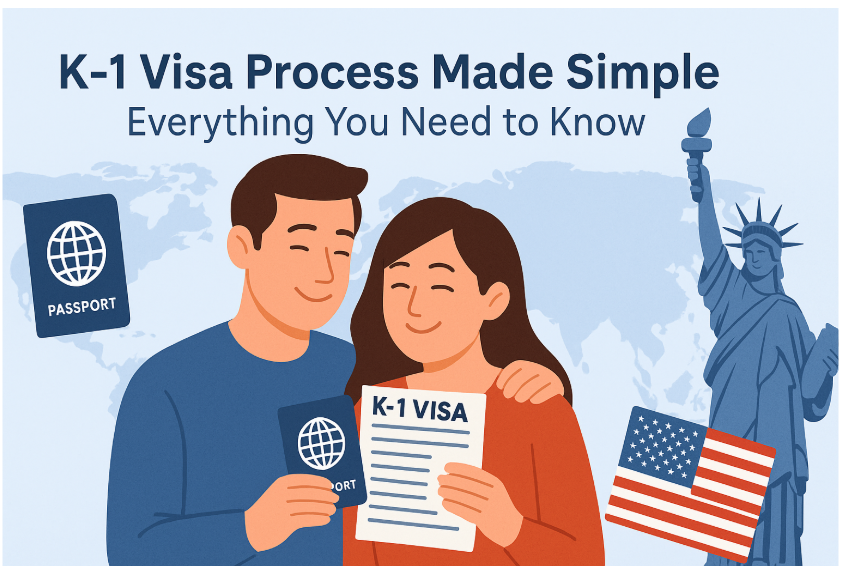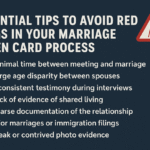
What Is the K-1 Fiancé Visa and Who Is It For?
The K-1 visa, often called the fiancé or engagement visa, allows a U.S. citizen to bring their foreign fiancé(e) to the U.S. for marriage. The couple must marry within 90 days of the foreign partner’s arrival. After marriage, the foreign spouse can apply for a green card.
This visa is ideal for engaged couples who haven’t married yet but want to start their life together in the U.S. Unlike a spousal visa, it doesn’t require marriage before applying, making it perfect for long-distance international couples.
While the process involves USCIS, the State Department, and U.S. embassies, with proper evidence and planning, it’s a direct path from engagement to permanent residency.
Step-by-Step: From Engagement to Arrival in the U.S.
The K-1 visa process begins when the U.S. citizen files Form I-129F with USCIS, including relationship details and proof of engagement. After approval, the petition goes to the National Visa Center (NVC) and is then sent to the U.S. Embassy or Consulate in the fiancé(e)’s country.
Next, the foreign fiancé(e) submits Form DS-160, gathers documents, completes a medical exam, and attends a visa interview. Once approved, they receive the K-1 visa and may enter the U.S.
The couple must marry within 90 days of entry. While the process has multiple steps, proper planning ensures a smooth path to starting your life together.
Filing Form I-129F: What You Need to Know
The K-1 process begins when the U.S. citizen files Form I-129F with USCIS to prove the relationship is real and the couple plans to marry within 90 days of arrival.
You’ll need to submit:
● Proof of U.S. citizenship
● Evidence you’ve met in person within 2 years
● Passport-style photos
● Statements of intent to marry
● Relationship proof (photos, messages, travel records, etc.)
The filing fee is $535 and processing typically takes 6–10 months. Once approved, the petition is valid for 4 months and may be extended during consular processing.
Getting this step right sets the tone for the entire K-1 journey—accuracy and strong evidence are key.
USCIS Review: What to Expect After Filing
After submitting Form I-129F, USCIS will send a receipt notice (Form I-797C) confirming they’ve received your petition. An immigration officer will then review your application for completeness and relationship credibility.
If more info is needed, you may receive a Request for Evidence (RFE). It’s not uncommon—just respond thoroughly and quickly to avoid delays.
If approved, you’ll receive an approval notice (Form I-797) and your case is forwarded to the National Visa Center (NVC).
This review phase may take several months. Use this time to prepare for the next step: embassy processing and the visa interview.
NVC & Embassy Processing: What Comes Next
Once USCIS approves your petition, it goes to the National Visa Center (NVC), which assigns a case number and forwards it to the U.S. Embassy in your fiancé(e)’s country.
Your fiancé(e) will then:
● Complete Form DS-160
● Schedule a medical exam
● Gather documents: police certificate, birth certificate, proof of relationship, and Form I-134 (Affidavit of Support)
Embassy procedures vary, so follow their instructions closely. This stage is document-heavy—timely preparation is key to avoid delays.
Finally, your fiancé(e) attends the visa interview. If approved, the K-1 visa is typically issued within a few days.
K-1 Visa Interview: Questions, Red Flags & Tips
The K-1 visa interview is the final step, held at a U.S. Embassy or Consulate to confirm your relationship is real and legally valid.
Expect questions like:
● How did you meet?
● How often do you talk or visit?
● What are your future plans?
● Basic facts about each other’s lives
Red flags include:
● Big age gaps
● Short relationship history
● Prior immigration issues
● Conflicting answers
Bring:
● DS-160 confirmation
● Medical exam results
● Passport
● Financial documents
● Strong relationship proof
With honest answers and solid prep, most couples succeed and move on to entering the U.S.
Entering the U.S. on a K-1 Visa: What to Know
After visa approval, your fiancé(e) can travel to the U.S.—but entry is not guaranteed. At the port of entry, a CBP officer will review documents and ask basic questions to confirm identity and intent.
It’s smart to carry:
● A copy of the I-129F approval
● Sealed medical exam (if applicable)
● Proof of your ongoing relationship
Most are admitted smoothly. Once in, your fiancé(e) has 90 days to marry the U.S. petitioner. That timeline begins immediately upon arrival.
Getting Married Within 90 Days: What You Need to Do
Once your fiancé(e) arrives in the U.S. on a K-1 visa, you have 90 days to get legally married—no extensions allowed. Missing this deadline can lead to serious immigration issues.
A simple courthouse wedding is enough for USCIS. You can always celebrate later. Just be sure to get a certified marriage certificate—you’ll need it for the green card application.
This is also the perfect time to start preparing for adjustment of status to secure permanent residency.
Adjustment of Status: From K-1 Visa to Green Card
After marriage, your spouse must file Form I-485 to adjust their status from K-1 visa holder to permanent resident.
Key documents include:
● Marriage certificate
● Form I-864 (financial support)
● Medical exam (if not submitted earlier)
● Proof of a real marriage
You can also file for a work permit (I-765) and travel document (I-131)—these take about 3–6 months to process.
The green card interview usually happens 8–14 months after filing. If approved, your spouse becomes a conditional resident for two years.
Common Pitfalls & How to Avoid Delays
The K-1 visa is closely scrutinized, and small mistakes can lead to major delays or denials. Common issues include:
● Incomplete or inconsistent documents
● Weak proof of relationship
● Missing deadlines (e.g. 90-day marriage rule, AOS filing)
● Poor interview prep or giving incorrect info
To avoid trouble, stay organized, be truthful, and follow every step carefully. Many couples hire an immigration attorney to ensure accuracy and peace of mind.
With preparation and transparency, the K-1 journey is fully manageable.




